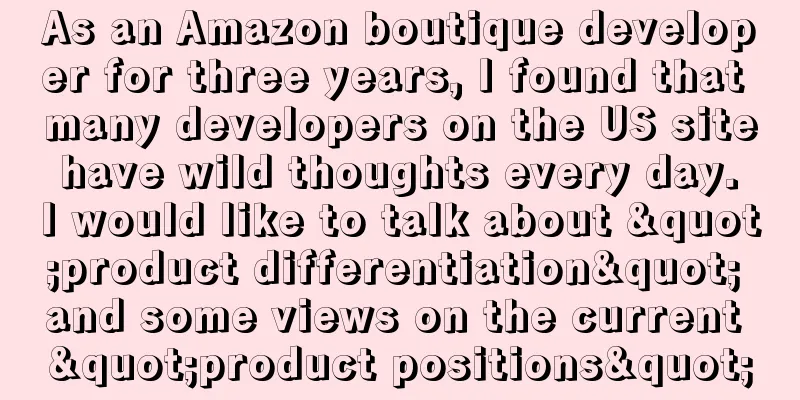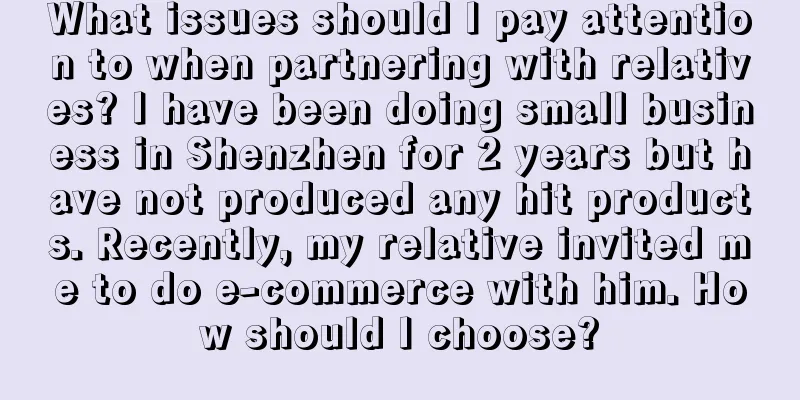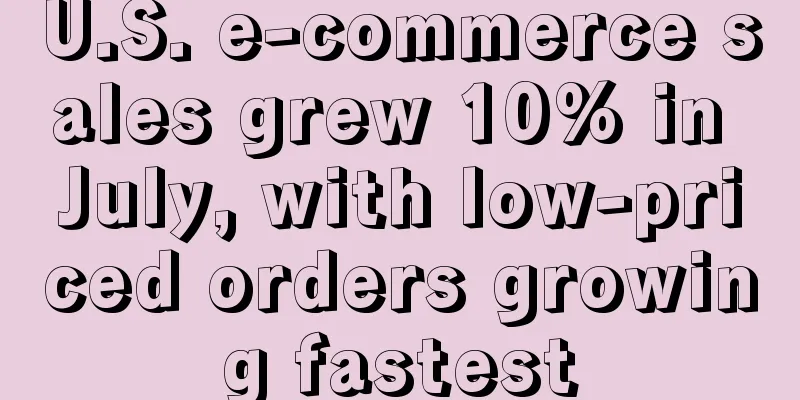|
I joined Amazon in October 2020. I hope to share my inspiration and resonance on how Amazon's current product personnel can make good products. My writing is not good, so I dare to share it, please forgive me! 1. The underlying logic of product value From the underlying logic, products are there to solve users’ problems, and users buy products in the hope of solving their problems. Therefore, Amazon’s current philosophy is to compete with its products and take advantage of its competitors, rather than returning to user thinking. Even if it is the world's number one brand, if it makes an anti-human product, users will still abandon it. What users buy is the value that the product brings by helping them solve problems. Therefore, value is the core of the core of the product. Creating value, altruistic thinking, and ultimately self-interest. For example: Users buy thermos cups to keep warm, to solve the problem of being able to drink hot water for a long time. If everyone else does not keep warm, but you do, what data analysis do you need? Trend analysis? 2. A brief discussion on data analysis on the market There are a lot of people doing fancy data analysis every day in the market. (Of course, I did this for a year) What about market size, degree of competition, market trends, fancy things, and some product managers with many years of experience are very proud of it. We analyze 6 major dimensions and dozens of minor dimensions. Is it effective? Who doesn't know how to do it? All the operators know how to do it. Are the skills that everyone knows still useful? Will new products with a high proportion of new products definitely sell well? I'll kill you if I go in~ Is it impossible to sell products with high product concentration? My product solves user problems and creates value for users, so why don’t users buy it? Just because you have the largest market share, will users not buy it?
3. Talk about differentiation I found that many people differentiate for the sake of differentiation. I don't understand . Do you make products without thinking? Do you differentiate without thinking clearly about the principle? Is differentiation effective? Since no one can guarantee it, then the word differentiation is a representation. What is the essence? The essence is to be needed by users and create value. So the word differentiation is inductive. Creating value and being needed by users is the principle, which is deductive. Differentiation is just an appearance that people see~Product development function: Let’s talk about the development of high-quality products. Let’s talk about the history of product positions first. The position was first established by Procter & Gamble, who proposed that one person connect the market and the production end. In China, Internet product managers have been promoted and there are many courses and books on Internet product managers, but there are very few on hardware. Specifically, I think we should call them hardware product managers. In fact, it is just the position called product manager. In our Amazon industry, we think that product managers are managers. In fact, product manager is just the position title, with such terms as junior, intermediate and senior. I think the most important ability for a product position is the ability to see into needs, define products, and make trade-offs. Hardware products are a balancing act between cost and demand. If you combine them well, you are awesome. Of course, innovation is also based on user needs. The second is to understand some technology. Hardware product managers also need to understand some technology, otherwise they will be laughed at by R&D. However, you don’t need to be proficient in it, but you need to be able to understand it. You need to have some basic techniques, how things are made, how much customization costs, and how much the minimum order quantity is. Otherwise, you may think a market is good, but the minimum order quantity is tens of thousands, and the mold fee is tens of thousands. That's a waste. I found that many developers in the US site are just imagining innovations every day, but they don't really understand the product process and materials, and are fooled by the factory. It's terrible. (Of course, I used to be like this~)
Innovation is to create value. You solve the user's problem and the user pays you money in return. I think there are two paths to innovation. The user task theory of the father of innovation. I recently read his book and found it very rewarding. It provides a new perspective to solve innovation problems. Innovation is never just about technological innovation. 5. Now let’s talk about the method 1: Find new user tasks to be done, such as a cup. The user is my colleague. It seems that there is no room for innovation in the cup. But he uses it to make something to eat in the morning. Maybe because he is in a hurry to go to work in the morning and cannot buy breakfast, he uses the cup to make some oatmeal or something. Then we can develop a cup that is more suitable for users to use for breakfast for this task.
2: Find the user's problems in the existing tasks and help them complete the tasks better, which is what we often do, namely, negative review analysis. However, negative review analysis needs to be analyzed according to the situation, which will be discussed in the future. For example, it is very troublesome to print student homework with a home printer. A certain brand has launched a mobile phone with one-click printing, which solves the problem, improves efficiency, and creates value.
"Wonderful Reply"
Supply Chain Development Liu Da - Supply Chain + Product Agree with: crysea, spywolk, embrace without distraction, DTMDPD, 者行孙 More » I have read the post carefully and agree with you. I am 30 years old and live in Shenzhen. I started to engage in cross-border e-commerce in 2019. During this period, I worked on the operation/development of Shopee, Meikeduo, and Amazon platforms. Now I am doing product development in a startup Amazon company. There are seven or eight people in the company. I am the only one in the development department.
However, the company's resources were limited, and the cost of plastic molds and even silicone molds was higher than the company expected. When I first joined the company in March 2023, I felt like a good cook can't cook without rice. And this was also my first official Amazon development job. Although the boss was optimistic about my ideas, he didn't trust me very much.
After a while of hitting a wall, I started to review my workflow:
1. Find products with good data and suppliers
2. Write a bunch of forms that companies won’t even look at
3. Procurement. Communicate with the artist to draw the picture, find the manufacturer to get the certification, and check the patent.
I began to realize that this kind of workflow was so standardized that I didn't even need to think. I prided myself on my rigorous logic and my unconventional thinking, but in this situation, I found that my skills were completely useless.
An accidental supplier delay prompted my first change. Because of the delay, I had to find a new supplier nearby, and I went on a business trip for the first time to inspect the factory and negotiate business. I began to awaken my sales soul (I worked in sales for a few years but gave up because I didn’t like socializing). From a certain day in April 2023 to today, I have been to this factory more than 20 times (it is 80 kilometers away from my company, and it is quite tiring)
From the boss to the factory manager, from the merchandiser to the production line worker, I was completely integrated into this factory. Every product that appeared, from my company to the other factory. Everyone was excited about this product. One day, the factory manager called me drunk and told me: I have been in the hardware industry for 20 years, and this is the first time I have made such an innovation. It will definitely be a hit. The boss had been losing money for seven consecutive years, but because of our product, he renewed the lease of the factory for another year. The merchandiser wanted to leave, but because he believed in our product, he insisted on another year after the New Year.
Everyone who has seen the finished product is excited about it. Of course, this is not the key to success, but when I look at the finished product myself, the back and forth, the negotiations, the months of optimization, the unexpected problems all seem to have paid off.
The product was launched, and after several months of struggle, it finally gained momentum in December 2023. In February, it began to stabilize the small category BS, with a price of about US$25. Now the US site has an advertising fee of US$120 a day and about 150 orders. The European site has a small category BS on the entire site, and there are about 60 orders a day without advertising. There are more than four months of peak season a year, and the sales volume is expected to be more than 500 orders a day during the peak season. The gross profit is about 35%.
During this period, relying on the factory, I continued to optimize two products with the same material but different functions. The second one was also launched recently. After one week, it received 30 orders without ads on the US site (it was placed on the main link and gained some traffic). The third one is now on my desk. There are still two final technical difficulties to overcome. It may take three days at the fastest or two months at the slowest.
At this point I turned my attention to the third product, a product that overturned 30 years of market conventions. It came from a ten-minute phone call between me and the factory manager. It was a sudden inspiration. In ten minutes, you understood me and I understood you. Then the factory manager drew a picture and made a prototype. One day later, the sample appeared in front of my desk.
It was not until this moment that I felt the significance of this job, which is a process of working hard for the functions (innovations) that customers urgently need and finally gaining market recognition. It is a taste of the feeling of adding and deleting five times and reviewing for ten years.
I am the dispatcher, coordinating all parties to achieve a balance. Externally, I am the spokesperson for the company, and internally, I am the spokesperson for suppliers. I speak for everyone, and everyone speaks for me.
Creating one exciting product after another is what I really want to do in this job.
During this period, I stopped being obsessed with data. Two weeks ago, I saw a product on the platform that excited me. It had 1,000 orders without any advertisements, and the average order value was very high. I stopped focusing on making tables, and instead found suppliers of non-standard products with pictures of competing products. Within a week, large samples appeared in my office, and now the products are being packaged and shipped to the United States.
From business negotiation to cutting molds, from sample making to mass production, from finding accessories to confirming packaging. These are complicated processes, while my colleagues are still just skimming the surface, I am already galloping on the grassland. Although this batch of goods may fail due to my excessive haste, when I go deeper into this supply chain, I have discovered a new idea worth millions that can be applied to this product. It doesn’t matter if it succeeds or fails for a while. In the peak season next year, this market will definitely be my home turf.
Most people agree with some broad concepts, and there is no value in arguing. I agree with your idea, but I want to add that product development requires in-depth development of the supply chain, which includes not only technology but also interpersonal relationships. Finding some buried geniuses can solve many problems. I am not a thousand-mile horse, but more like a Bole. Discover high-quality resources, and maybe your ideas can be realized. Several details behind the key inspiration require this great god behind the supply chain. Feifei Wakaka · Shenzhen I like to find products with very poor ratings in the category and then improve them. However, this is very likely to fail in the womb.
Supply Chain Development DaLiu Shenzhen @飞飞哇咔咔: Yes, often the idea is halfway through and cannot be executed. I think the best way is to have the opportunity to realize the idea (even if it is just a prototype). The faster it is realized, the faster the judgment will be. In this way, you can always find a feasible differentiated solution.
Endless screws • Guangdong I totally agree with the original poster's point of view. The strength of a factory lies in its years of deep cultivation in a single field, and its understanding of back-end areas such as product materials, production processes, and cost control. The strength of an e-commerce company lies in its close proximity to the front-end consumer market, its strong ability to explore market demand, and its fast response speed. An excellent product manager is the bridge connecting the two ends. Now that market competition is increasingly fierce, it will be difficult for e-commerce companies to produce explosive products if they go it alone and do not pay attention to the cooperation of the back-end supply chain. I am very happy to see such high-quality posts and answers on the first day of the Zhiwubuyan forum, hahaha! In addition, I would like to introduce myself. I am an LED light strip factory. Our factory has been deeply involved in the field of light strips for nearly 10 years. We are very familiar with various current LED materials and technologies, and have our own patents. All product managers are welcome to inquire!
Just a Clown • Jinhua Liu, my idol, is you. I really think that developers with a technical background can't go as far as developers with a sales background. The development itself is still a comprehensive ability and vision and inspiration, while sales have advantages in interpersonal relationships and people's grasp. As long as you have seen enough cases and enough factories, vision and inspiration will come naturally. Of course, the premise is still to have passion.
Anonymous user Agree with: Zhou Wenxia, Yi Xiaoyang, Li's God and Demon Thoughts, Yueyue 1706, Horseback Archery More » Thank you for sharing your views and experience on Amazon product development and product positions.
The core of the product is to create value: The core of the product is to solve user problems and create value. This is a very important point of view. The success of a product depends on whether it meets user needs and provides meaningful solutions.
Differentiation does not mean value: Differentiation is not for the sake of differentiation, and the difference is not the selling point. Instead, the differentiated features of the product should be determined based on user needs and market insights. The product should first solve the problem, and then consider how to highlight its differentiation in the market.
Two paths to innovation: The author mentioned two paths to innovation, namely discovering new user tasks and solving user problems. These are good methods that can help product managers find inspiration for innovation. In addition, constantly collecting user feedback and negative reviews is also the key to improving products and innovation.
Understand product production process: It is very important for hardware product managers to understand some product production processes and materials. This can help better cooperate with manufacturers and engineering teams to ensure product quality and cost control.
User Task Theory: Understanding user tasks and needs is key to product development. User Task Theory can help product teams better understand user expectations and challenges, thereby designing products that better meet user expectations.
The author's views emphasize the importance of user-oriented product development methods and innovation. These views are still very valuable for sellers and product managers who successfully develop and sell products on Amazon.
I would like to add some other opinions of my own:
It is easy for product managers to develop an empiricist mentality, that is, they are bound by some categories they have worked on in the past. For example, as mentioned earlier, differentiation should be for solving user problems and creating value. This is correct, but sometimes differentiation for the sake of differentiation can be a selling point of a product, even if it does not necessarily solve an obvious problem.
For example, some luxury brands’ products do not necessarily solve practical problems, but their differentiated designs and brand values attract certain consumer groups. Therefore, differentiation can also exist to meet emotional needs.
Discovering new user tasks and solving user problems are indeed effective ways to innovate, but sometimes innovation can also be about predicting market demand, that is, demand that users may not have noticed yet. This requires product managers to have certain market insights and foresight.
It is indeed important for hardware product managers to understand the production process and materials. However, in some cases, the manufacturing process may be constrained, resulting in the product not being able to be manufactured in an ideal way. Therefore, product managers need to consider manufacturability during the design phase to ensure that the product can be produced in a cost-effective manner.
User task theory is a useful concept, but sometimes user needs may be more complex and not limited to tasks. Users may also have emotional needs, social needs, etc., which also need to be taken into account in product design. In addition, user task theory does not always cover all user groups, so different types of user needs need to be considered comprehensively. In general, the author's point of view is very valuable, but in practical application, flexible judgments need to be made based on specific circumstances and market demand. Innovation and product development are complex processes that require comprehensive consideration of multiple factors, including market trends, competitive environment, user feedback, etc. Zhou Wenxia Wow, you are an expert. I think what you said is basically correct, but there may be some misunderstandings. User task theory or demand is divided into functional and emotional. Because I will write about it later, I just wrote a general idea and didn't write it. But based on the problem of differentiation, if it is a selling point, it must be purchased because of need, because luxury goods also meet the needs of vanity. Regardless of any differentiation, it is purchased because of need, and needs are divided into how many people need it. What I mean actually includes function and emotion. For example, the differentiation of maternal and infant toys is more about appearance, because babies have appearance or pattern requirements for products. When buying luxury goods and luxury cars, the user's need may be to show his own strength. It can also be said that his task is not only to need a car to take him to the destination, but also to have the task of business reception. You can learn more about it.
ed ward526 #The success of a product depends on whether it meets user needs and provides meaningful solutions. #
I have a question. I understand the first half of the sentence, but I don’t quite understand the second half. How do you understand “provide meaningful solutions”?
Su nny996 • Shenzhen @edward526 : Let me help you answer this question. Actually, you are confused about how to understand "meaningful" and what is meaningful, right?
In fact, in a simple sentence, it is whether your target group accepts your solution, such as:
1. Is the price increase acceptable?
2. If you provide a solution, will it cause new concerns for him? For example, a wooden cutting board is easily scratched by a knife. If you change the material to a stainless steel cutting board, the damage to the knife will be very large.
3. Is this solution difficult to implement?
4. The solution is not effective in the long term, etc.
edwar d526 • Guangdong @Sunny996 : Please advise
1. How to evaluate whether the price increase is acceptable?
2. How to evaluate whether the solution can be accepted at the user level?
Big words, big words • Hangzhou What the OP is talking about is exactly what I am looking for! I want to be a hardware product manager instead of just a product selector and developer.
Jimmy Liu Tianjin This kind of work is meaningful and interesting, but there are very few such positions. The company I can think of is Xiaomi, many of whose products can meet user needs and can be implemented in practice.
Anonymous user Agree with: ghostallwin, weak, Sunny996, horseback archery, Zhou Wenxia more » I will also briefly talk about my views on the product, just for communication.
In the past few years, I thought traffic was king. Even ordinary products could increase the upper limit of links infinitely through capital operations. Once the product is put on the shelf, there will be dozens or hundreds of orders. Who can withstand this? However, in the past two years, Amazon has cracked down on various violations (especially after 21 brands were punished), S orders, small cards, account compliance, scanning numbers, videos, etc., so sellers now pay more and more attention to white hat operations.
Under the premise of white hat operation, the gap between operations will be narrowed a lot (unlike the unreachable gap before when capital came up). At this time, it depends on your product and the internal strength of your connection. I think the product is the core.
Good operations require good products, and good products also require good operations. From the user's perspective, of course, the consideration is whether the product meets their needs. But from the perspective of operations, in a stock market, I will also give priority to how to carve a piece of meat from market competitors (as long as it meets the goal, I will even consider making a low-end product at a low price to grab market share).
We cannot develop products for the sake of developing them, or innovate for the sake of innovation. Just like a cup, its core demand is to drink water. I can plate the product with gold for the sake of innovation, but this may completely deviate from the product and user needs.
The market will slowly shift from a situation where supply is less than demand to a situation where supply exceeds demand (because sellers are so good at copying products), and the subsequent demand in specific scenarios is worth paying attention to.
Solving user problems is one development idea, but another idea is to develop around demand. For example, the original demand for a water cup is to drink water, so how to make users drink water better is also an idea.
Anonymous user Agree with: leeyayayayaya , As long as I am safe, there will be a good future , MattChyi , ccdzd1 , Lucyzhang - Data analysis is definitely effective.
- Create demand: If you have been in the industry for three years and can come up with ideas that countless factories and R&D teams cannot come up with after ten years of accumulation and exploration, then I admire you.
- If you don't have a rough idea of how much it costs to make a mold for each material and how much each process costs, then you are a layman and don't deserve to be called a product manager.
The example you gave was about development for a specific group of people. If you can come up with a market research report on the relevant group of Americans, that would be useful information. Otherwise, it would be nonsense. Are you planning to use the statement "you think it's a good idea" to get your boss to invest hundreds of thousands of dollars?
Braised Egg Head The overall idea of the original poster is great. User insights are always something that a product person needs to delve into. This reminds me of Pi HK's favorite questions to ask his product manager about the product:
1. Why do you want to make this product?
2. What changes have taken place in this product market in recent years?
3. What are the users and the scenarios they are in?
4.How are user needs classified?
5. Have user needs changed in recent years?
6. What needs does your product solve for users? What are its advantages and disadvantages compared with competing products?
7. What is the competitiveness of your product definition?
If every product made by a product person can answer these questions well, then I believe that this product must be a good product.
ed ward526 @Lu Dan Tou : @Zhou Wenxia : May I ask about point 4: How are customer needs classified? I don't quite understand this point. Can you give an example?
Braised Egg Head @edward526 : Basic needs (needs that must be met), expected needs (needs that customers hope to meet, plus points if they meet them, no points will be deducted if they don't), exciting needs (needs that customers may not think of, but you meet them and make them suddenly realize and excited), indifferent needs (it doesn't matter if they have them or not), reverse needs (points will be deducted if they have them). It's impossible to meet all customer needs. I usually classify customer needs like this, and then prioritize and consider the cost to meet the necessary needs. I hope you can add more, my understanding is relatively general.
Zhou Wenxia @盐蛋头: I don’t use the Kano model classification very often now, so I made it simpler. I divided it into functional requirements and non-functional requirements. The main thing I reviewed was the value of different requirements.
edwar d526 @卤蛋头: The demand classification of the kano model is more based on the results of questionnaire surveys to define the types of demand. However, 99% of the current cross-border e-commerce developers do not have the ability and resources to conduct questionnaires. What is the basis for this demand classification?
Zhou Wenxia @edward526 : I personally feel that this model is not very meaningful. Simply increasing attractive demand or improving expected demand still cannot solve the problem. Product solutions are functional trade-offs. I think it is meaningless to simply stack functions. Second, in the current situation of lack of resources, it is basically based on guesswork. For example, the hair dryer can dry quickly, which is very likely to be an expected demand. Adding storage function is an attractive demand, but it is not very meaningful. I think the core question is still how valuable this function is and how much people are willing to pay for this demand.
Braised Egg Head @edward526 : Actually, the model is not very important. The purpose is just to rank the needs so that some functional trade-offs can be made when defining the product. The basis for ranking is mainly the probability of mentioning in the comments and the video explanations on various websites. As the original poster said, the ranking of some needs may be based on guesswork or discussion with the operator on which one is the main selling point for promotion.
Very weak • Zhengzhou I would like to ask, charm demand refers to the demand that customers did not expect. This kind of demand is rarely seen through Amazon reviews. So how can we see the charm demand? If we guess the demand as you said, how can we define and judge whether it is a real charm demand? How can we judge the value and market of this charm demand?
Zhou Wenxia · Shenzhen @虚弱的很: For example, thermos cups now have a temperature display function, which was not available before. However, I have not heard of anyone giving bad reviews for not having a temperature display function. However, users will say that they sometimes burn their mouths. This will not be a bad review, but it is a real problem of users. It depends on how you grasp it. Then, if you want to accurately judge how much market this demand is, you must have the resources to do more questionnaires. Otherwise, just rely on your own feelings.
This problem of burning the mouth is something that everyone will encounter in life, so it is relatively easy to judge. Although there is no quantitative data, you can probably know it. Then think about it yourself. If you add a temperature display to prevent the mouth from burning, will anyone accept the price increase of 5 yuan? Or should you just give it a cost-effective price and increase the quantity without increasing the price?
Very weak • United States I understand the explanations about demand, market appearance and commercial pricing judgment later. My main question is about the insight and authenticity of the charm demand. Since we are talking about the thermos cup, I happen to be using a digital display thermos cup, so let me use this product as an example to discuss.
Burning the mouth is a problem that customers have, but is this problem what customers really want to solve? Is adding a digital display a charm attribute? From my personal point of view, I rarely really use the digital display to decide whether to drink water to avoid burning my mouth. My usual jtbd is that when I am thirsty, I open the water cup and drink water. If the temperature is too high to drink directly, I blow it and then drink it. During the whole process, I basically don’t look at the digital display temperature. In the past six months, I should have only looked at the digital display temperature once or twice, but it was just a look, not related to worrying about burning my mouth.
So is the burning mouth a "real" problem? Is adding a digital display a need for charm? How to judge the authenticity? We lack the resources and capabilities to gain insights into consumers and the market, so we can only review the scope that we can control several times; of course, I am just an example.
This brings us back to the question I asked at the beginning. In channels like Amazon e-commerce, we have fewer channels to gain insight into user needs. From the comments, we may be able to analyze the customer's potential problems. How do we judge which is the attractive attribute that the customer wants? How do we judge its authenticity? Which one is more important? In addition, the e-commerce channel itself has certain limitations in product creation.
For innovative products, the analysis, authenticity, and ranking of attractive attributes are particularly important. As for the commercial pricing of attractive attribute products, in my opinion, if they are real attractive attributes, then the product should have a controllable pricing adjustment space.
Suzhou Cross-border People - Overseas Product Development Team, looking forward to fate! I have been developing new products for more than 10 years. I have made hundreds or thousands of prototypes. In many cases, the idea stage is good and exciting, but often in the process of prototype testing, new creative ideas may be able to achieve expectations, but often unexpected problems are found. In short, new functions and highlights are developed, but new problems are also brought about, such as difficulty in cleaning, not waterproof, etc.
When it comes to product development and innovation, domestic companies try their best to come up with new ideas with existing products. Market research is not given much attention, and many companies don’t even know how to do it. Take the thermos cup mentioned by the OP for example. Insulation is just a basic function. Meeting this function is a basic requirement. If it fails to keep warm for a long time, it can be said that the product is unqualified. However, creativity and other ideas are needed.
For example, for people who ride bicycles, if you ride a bicycle, you will know that it is not so easy to drink water while riding a bicycle. Straw-type cups are inconvenient because the frequency of mouth breathing is very high when riding a bicycle (for professional cyclists). Drinking water through a straw with your mouth will make you feel uncomfortable. If you use an ordinary water cup, you need to turn the cup upside down and tilt your head back to drink water, which is even more inconvenient when riding a bicycle.
So how do we develop this kind of product? We have developed this kind of product. Simply put, creativity can be targeted at a specific group of people, so that you can avoid competition and get your own piece of the pie.
One leaf falling tells the coming of autumn - I like reading, I like Keigo Higashino Agree from: Mr.Haha, Dongfengpo, Lucyzhang, IAMKriz The essence of product development is this, but because of the different business needs of each company, different needs for product development are derived, and the focus of capabilities is also different. R&D-type development may be suitable for some vertically deep-rooted and well-funded companies, who can be the first to try it out. For small and medium-sized sellers, they need more people who can quickly find suitable products to sell, also known as product selection.
Data analysis is a method to understand the overall market situation, competition, dig deep into user needs, and discover potential customer groups. Development positions also need to report these data to the upper management to recognize your point of view and ensure the smooth establishment of the product project;
Most people can present data, but not everyone can judge and dig out the hidden information behind the presented data. This is one of the core competitive advantages of product development. Many data analyses on the market now may be more for the sake of data, while ignoring the essence of data analysis which is just a way to find products that meet consumer needs.
If the premium brought by the created value is too high, it will not be accepted by consumers. Consumers only accept products that meet their reasonable expectations.
The needs derived from the comments actually need to be further identified. It is necessary to distinguish between true needs and false needs. What customers say is not necessarily what they want. For example, the two examples may be false needs. Then, even if you make innovations, they may not be accepted by consumers. Mr. Haha • Shenzhen I agree with the first paragraph. Product development serves not only customer needs, but also the different business needs of each company. Let me take this opportunity to talk about the topic of differentiation for differentiation's sake. Some companies' products are biased towards a certain style, which may not generate growth in orders and may be seen as useless differentiation in the eyes of others (of course, it may also mislead others into thinking that this is also a user demand). It's just that its service objects are mainly the company's business needs.
Anonymous user Endorsed by: MattChyi, Horseback Archery, GreatGatsby, Wongtoseefull, moyell I didn't type the right word. What you want to express in your article is to discover new needs. All your points are to say that you can think of new needs that others cannot think of.
It's not that you are better than others, nor that I look down on you. It's just that I have seen too many developers and factories with more than five years of experience trying to create some so-called new functions, but in the end they all ended up with bad results.
Only through experience can you know that new products that have not been tested by the market are all very risky. Even if you look at some annual design awards and innovation awards abroad, most of them are just micro-innovations. And some very novel innovative products have only average sales afterwards.
Of course, if you want to make some unpopular products that the mainstream market doesn't pay attention to, such as raising a parrot, exploring its needs, and designing a toy, it is still feasible. If you want to play in the mainstream market in this way, you simply look down on the thousands of people working in this field. Zhou Wenxia Time and experience are not necessarily equal to ability. The best way is to study why new features are unpopular. Use scientific methods to conduct preliminary research on whether new features are popular. - New products that have not been tested in the market are all very risky - This describes the appearance. You can expand on why this is the case and what the essence is. Perhaps you can solve the problem better.
ze her • Changsha @周文霞: Your statement is very similar to a product consultant hired by my previous company. He was hired at a high price but had no performance. He also boasted about how great the product was before the product was released. He boasted about new needs and new products. After the product was released, no one bought it even at a low price to clear the inventory. Our entire team has also reviewed the situation again and again, summarizing the reasons for failure. In the end, the conclusion is that new products that have not been verified by the market are risky, so don't try them rashly.
Horseback Archery · Shenzhen @zeher : After this failure, did you find any method to verify the market demand in advance? If the only conclusion is: new products that have not been verified by the market are risky, it is better not to try rashly. It is not worth losing money.
Anonymous user Agree from: Lucyzhang, AAA Soda Cracker Wholesale After reading the original poster's content and the comments below, I would like to add a few points for your reference.
1. Human energy is limited. No matter if you are a product developer, a product manager, or a R&D personnel, it is already remarkable if you can make certain achievements in one or two product areas or certain categories.
2. For most trading companies, the key to negotiating with suppliers is quantity. If the quantity is not enough or does not meet the factory's expectations, it is actually very difficult for the other party to give you a new product that they have been working on for a long time.
3. Operation, development, and the boss’s perspective.
From what I have seen, operations are more concerned about whether new products can be sold, whether consumers will pay for them, whether the price is too high, whether there are many competing products, when can they make a profit, whether orders can be stable, etc.
What developers care more about is the market size, whether there is a growth trend, whether other peripheral products can be made if it is successful (after all, it is not easy to launch a product. If it sells well, it will be easier to expand into peripheral products, which is also conducive to the brand route), the quality of each supplier, which one is more cost-effective (after all, it is not enough to just have a cheap price. What if the cheap quality is too poor, and there are a lot of returns after two months of sales, and the operation will have to come to greet me), etc. As for the boss... I only know that the boss cares about profit. Zhou Wenxia · Shenzhen Many e-commerce companies currently do not apply to branding because many products do not have product opportunities to innovate. Then you sell hot products and sell the same products, and the operation is not enough. In the end, it has to be a product pot, so I often don’t understand whether the product manager of pots and pans should be damned, haha
miz ili • Shenzhen @Zhou Wenxia : Haha, in fact, everyone is a retailer. If you don’t have enough ability to build a brand, you are a little overestimated. At that time, many people said they wanted to learn from Anker, but they really had to spend money on R&D, and investors were afraid. Just like so many bosses went to Pangdonglai to visit and study, they really understood how Yu Donglai played, and they went back one by one.
xi ang0066 • Ningbo @mizili : So how did Pang Donglai play? Can you recommend an article or book to read?
Derk 's Home • Shenzhen @Zhou Wenxia : You are right. The operation and the boss just sell it or not to make money. Nothing else is considered by him.
i6 Professional Product Developer - Have your own design team, production team, main business (car supplies, mobile phone bracket accessories) I have been developing products for 6 years and have some small ideas, and I will criticize them.
Product innovation: It is a problem that everyone focuses on every day. The prerequisite for innovation requires a large amount of information collection. A qualified developer needs several basic requirements.
Have a clear understanding and understanding of all competitor products in your category. All the advantages and purchasers of each product in top 100 should be conducted to draw conclusions in this industry.
Have a clear understanding of the 20 or 10-year evolution process of your category development history.
Find out the 10 best suppliers in your industry and build relationships with them to build the latest information tower
Have a clear understanding of all product usage scenarios in the market
4 points are the most basic. After understanding these, we will talk about our own ideas. Avoid unnecessary waste. I have developed several popular products in recent years. If you have any development issues, we can discuss them together. Now we are R&D factory car supplies and mobile phone peripheral stand products. If you are interested, you can communicate together.
Trend product selection superb - product selection data analyst Identify your concept of data analysis on the market - everyone knows how to use their skills?
99% of the data analysis on the market are based on BS100's sales data that month . This thing is of no use in all aspects. So why are various companies still doing such things?
First of all, the very important point about data analysis is: data analysis is actually about finding information differences , and information differences can be turned into product differences, can be turned into acquisition of customer demand points, etc.
But if everyone uses the same method to find information differences, then is this information difference called information differences?
Therefore, the market has always had the need to analyze objective and comprehensive data . Everyone knows that the success rate will not be high if the judgment is purely subjective and without data support, and this success is likely to be difficult to reproduce.
Most companies can recognize this problem, but there is no good solution . They can only recruit basic data analysts while looking for effective "product selection plug-ins" everywhere, or searching for Google Trends or other data to assist decision-making, but these methods actually have not entered the kernel.
Here we share more effective data analysis ideas and cognition.
1. The premise for the effectiveness of data analysis is whether the data source used is accurate and comprehensive, whether the idea of data mining and processing is in line with actual needs, and whether the conclusions of data analysis can be implemented. You can work hard to improve your analysis in this regard.
2. It is recommended to refer to the post I posted about ABA. Basically, the methods and ideas are stated. Combined with chatgpt, most people can use ABA data in a complete time dimension for analysis, which can be better than at least 80% of Amazon companies on the market.
Travel clock 1234 There are basically two ideas for product selection (opening and following):
One is that demand is uncertain, and I will be the first to try it out. This mainly requires understanding of users and understanding of demand. You see that the market popularity of a certain product or element is increasing, but the market supply is insufficient.
The second type is copying: the demand for this product has been verified, but I judge that the strength of the competitors in the market is insufficient and I can fight. Then I will go in and do it. The key here is that there is no need to guess the demand, the demand has been verified. The key is the analysis of the competitors, and you can fight the competitors.
Sometimes it’s okay to not be able to beat it, because the market can eventually survive multiple players, but you can’t eat the fattest piece of meat. For example, the opponent sells $25 for 100 orders a day. You can also make some money by selling $20 for yourself, 25 orders a day.
The core idea is: find weak teams/individuals who have discovered opportunities but their own resources and abilities are not enough to completely eat up this opportunity.
Anonymous user Agree from: ghostllwin, Li's gods and demons, Li's, braised egg head, red should not be forgotten, invincible little wheat More » Product development, many times differentiation is micro-innovation. In terms of market public models, we make some appearance differences or make matching combinations. The products we buy well can directly make different vertical variants, colors, sizes, appearances, etc. If private models are rare on the market, we should pay attention to market demand issues and not be overly stocked. There are several models that we developed and designed and produced. They used hundreds of thousands of yuan to open the mold and were sold later. There are many problems, such as the design defects, the demand is not as high as expected. After preparing a lot of goods, they directly lost a lot.
Now we develop a lot of ways to observe BS and then directly require improvement methods on BS, doing market research and layout categories. Compared with competitive products, our products must have advantages, such as improvements in cost, functions, and appearance, and then what can be done in pictures is better than competitive, that is, differentiation, plus the capital chain and ROI calculations, we can directly develop according to the plan.
Newbie little white bubbles As a novice, I have several immature questions to ask:- If you don’t do fancy data analysis, how can you push the product to the operation and put it on the shelves? Especially if you haven’t done much operation in this category, how can you convince him to put the products you developed?
- Is the fashion category not very suitable for this innovative approach?
- Faced with the company's assessment of the development quantity requirements, how can we achieve innovation well (most of our developments choose existing styles from the market, so we think this innovation is difficult)
Is it more suitable for innovation you mentioned? It feels a bit difficult to develop innovation.
Supply Chain Development Liu • Shenzhen @Newcomer Xiaobai Bubble: 1. I can’t do fancy data analysis at all in the early stage, but I can use enthusiasm, which sounds a bit ridiculous, but enthusiasm largely determines your confidence. If you have confidence in your products, share it with your operations. When they read your confidence from your eyes, they may be willing to give it a try. When I entered the industry, I survived in such a stupid way.
2 Fashion categories are not suitable for this method, because innovation in fashion categories is more related to aesthetics and does not form a common standard. Pain points and refreshing points are two directions. What the poster is talking about here is pain points.
3 It is basically difficult for companies with development quantity requirements to achieve differentiated innovation unless they have strong factory resources to cooperate.
4 Development and innovation are not out of reach, but the company needs to have a corresponding environment. If you find it difficult now, it is because the company does not have such an atmosphere and you do not have such experience.
Anonymous user The theory is not wrong. It is certainly supported that demand determines value, demand determines market, and differentiation and demand improvement are not as expensive as expected. Sometimes, you can use the existing mold in the factory to make a little change. I guess most of the people who criticize you will get goods from traders, and they will not even come into contact with the factory level. They will think that your theory is high-end, but cannot be implemented.
TX123456 Although I am not a developer, I think this kind of development is in space... In this era of big data, any product has basically been developed to the extreme. It is enough to meet the needs of customers... These so-called innovations are different from personal opinion. Are hot products all new features? Obviously not. Which old products do not meet the needs of customers? . . . . . . . . . . . . . . . . . . . . . . . . . . . . . . . . . . . . . . . . . . . . . . . . . . . . . . . . . . . . . . . . . . . . . . . . . . . . . . . . . . . . . . . . . . . . . . . . . . . . . . . . . . . . . . . . . . . . . . . . . . . . . . . . . . . . . . . . . . . . . . . . . . . . . . . . . . . . . . . . . . . . . . . . . . . . . . . . . . . . . . . . . . . . . . . . . . . . . . . . . . . . . . . . . . . . . . . .
Horseback Archery In the third year of product development, a lot of what the poster said were problems that he usually thought about and wanted to solve. The poster’s idea gave me a clearer direction and was very grateful. I agree with the ability to define products and trade-offs. Hardware products are the limits of cost and demand. At the same time, I personally believe that only by understanding materials and processes can we provide a foundation for new innovations
zeher Agree from: Cross-border wheat home, GreatGatsby, Ordinary Life, lee2513, More » The idea is full, the reality is very skinny. The fact is that when you enter a new category, the most conservative way is to refer to Amazon competitors, do some minor differentiation, and dig deep into this category, accumulate experience and resources. First of all, don’t think about digging out any needs that others can’t think of. Not only is the time cost wasted, the ending is likely to be cool. Zhou Wenxia • Shenzhen You have never seen the products I made, and there is no high probability that they will be in trouble. Why do you have to stick to your existing cognition and not look at anything other than your cognition? At least you can study it first~~
Fel ix2020 • Shenzhen Probability issues, 70%-80% of products are like this; the remaining 20%-30% spend time discovering with the manager and racking their brains to innovate; it is difficult to see results in a short period of time.
|










